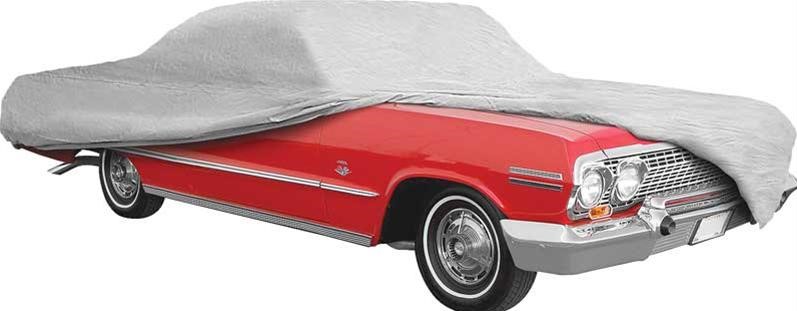A good car or truck cover is essential for winter storage.
For many of us, though, the need for good vehicle covers extends beyond the winter months. We’re looking to protect our rides from spring pollen, summer sunshine, fall leaves (and falling acorns). And we may not have the garage or garage space to provide the protection.
Even if we are fortunate enough to have a three-car garage, we may require the added protection of a car or truck cover to protect against dust build-up or moisture—or maybe even dings and scratches from the kids. The key to picking the right cover—and there are a lot to choose from—is an honest assessment of your climate, surroundings, and driving habits.
Outdoor vs. Indoor Car Covers
Are you parking or storing your vehicle inside or outside?
The answer to this question will help you select the best material for your vehicle cover. Indoor and outdoor car or truck covers are tasked with protecting your vehicle from different things, so they often use different fabrics and materials to accomplish that.
Think about it—outdoor car covers must protect from the elements, including:
- Rain/moisture: penetrates into scratches and cracks to cause corrosion.
- Snow: another cause of corrosion.
- UV rays: harmful rays from the sun can cause paint to fade over time.
- Pollen: along with other outdoor airborne elements, pollen can become abrasive and cause tiny paint scratches which can lead to other damage.
Most outdoor covers use a multi-layer design that incorporates up to four layers of woven fabric, usually including polyester, polypropylene, or other materials that protect against moisture, dust, sunlight—or all of the above. You can find many high-quality, all-weather covers, but you can also tailor your outdoor car or truck cover selection to your particular climate.
For example:
- If you live where there are four distinct seasons (think Midwest or Northeast), go with an all-weather style cover: OER Weather Block Plus Car and Truck Covers, Summit Racing 4-Layer Car Covers, and Covercraft Technalon Evolution Universal Covers
- If you live in a particularly rainy area (Pacific Northwest, for example), pick a cover with outstanding water resistance. Keep in mind, no cover is completely waterproof (despite the name). This is because car covers must remain breathable to prevent condensation from settling on your vehicle’s finish. Options include: Coverking Stormproof Car and Truck Covers
- If you’re vehicle will be subjected to heavy snow, you can opt for a cover biased toward outstanding water resistance: Coverking Stormproof Car and Truck Covers and Roush Performance Stormproof Covers
- If you live in a dry area, you may want to go with a cover that keeps dust from filtering through. An excellent option would be: OER Diamond Fleece Car and Truck Covers
- If you’re lucky enough to live in a mostly sunny place, make sure your cover provides good UV protection. Possibilities include: SLP Performance Car Covers
In addition, depending on where you typically park your vehicle, your cover may need to provide protection against bird droppings (under trees or wires) and/or impact (along busy streets). These are all things to consider when buying a cover for outdoor storage.
Indoor covers aren’t exposed to the elements, but they still need to provide protection against:
- Dust: debris can settle on your paint and, over time, cause tiny scratches on the paint.
- Finish damage: indoor covers often offer a soft inside to pamper your vehicle’s finish.
- Mildew and/or rot: moisture expelled from breathable covers often seeps through to the outside of the cover and settles. Over time, this can cause mildew or rot and compromise the protection of your cover. Many indoor covers are treated to resist rot.
Good quality indoor covers include OER Diamond Blue Car and Truck Covers and OER Titanium Plus Car and Truck Covers.
Factor in Vehicle Usage
Will your vehicle sit for long periods? Is it a daily driver?
Vehicle usage plays a role in proper cover selection. If you use your vehicle every day, you’ll want a lighter-weight material. Choose the lightest cover that provides adequate protection for your indoor or outdoor storage needs.
If you’re putting your vehicle in long-term storage, you’ll want to choose a heavier cover. Thicker materials provide better protection against dings and minor accidents, which are more likely to occur over a longer time period.
Universal vs. Custom-Fit Vehicle Covers
There are some good universal cover options out there, but we’d recommend going with a custom-fit design in most cases.
Custom-fit covers are designed to hug the contour of your vehicle, so there are no avenues for contaminants to reach your vehicle. Simply put, they offer the ultimate in protection compared to universal covers. And while universal covers may be cheaper, you often get what you pay for!
Winter, summer, spring, or fall—there’s likely a car or truck cover out there for your specific needs!


[…] There definitely are determining factors that should define and dictate the type of car cover to choose for your car. Here is a detailed description of what you should look into prior to settling on the final choice of a car cover. […]
Firstly, thanks for sharing this amazing article. I appreciate that you talked about choosing a car cover. My younger sister wants to buy a brand new car and she also wants to buy a car cover for her car. I hope that this article would be helping her.
Polypropylene and polyethylene are the most common outer cover materials, giving varying levels of rain protection. Cheaper car covers may just be a single layer, which are fine if they’re on and off on a daily basis, but they are not recommended for long-term storage because they can trap harmful moisture. If possible visit this website https://www.durasteel.co.nz/ to gain more idea or tips on the same.